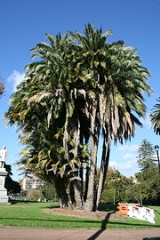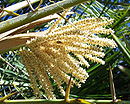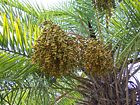
Phoenix reclinata
Encyclopedia
Phoenix reclinata or Senegal Date Palm is a species
of flowering plant
in the palm
family native to tropical Africa
, Madagascar
, and the Comoro Islands
. The plants are found from sea level to 3000 m, in rain forest clearings, monsoonal forests and rocky mountainsides.
 P. reclinata is a dioecious
P. reclinata is a dioecious
clumping palm, producing multiple stems from 7.5 to 15 m in height and 30 cm in width. Foliage is pinnate
and recurved, growing 2.5 to 4.5 m in length and 0.75 m in width. Leaf color is bright to deep green on 30 cm petioles
with long, sharp spines at the base, with 20 to 40 leaves per crown.
The plants are unisexual and florets appear at the top of the palm stem. Male florets are a dirty, pale yellow and fall off after blooming; females are small, globose and yellow-green. This species grows edible, oblong fruit
, orange in color (when ripe), at 2.5 cm in diameter. The fruit are borne in large, pendant clusters and contain one seed each.
Palms across the Phoenix
genus
readily hybridize with one another resulting in naturally occurring variations. They usually tolerate salt-spray, and moderate drought where the water table
is permanently high.
 In addition to the fruit, which attracts animals as well as humans, the palm heart
In addition to the fruit, which attracts animals as well as humans, the palm heart
can be eaten as a vegetable. In Natal, South Africa
, and the Okavango Delta
, Botswana, the sap is tapped shortly before flowering to make palm wine
. The fibres of young, unopened leaves can be used to make carpets, kilts and brooms. The roots contain tannin
and can be used to make a brown dye. They also produce an edible gum. The wood is lightweight and not particularly useful.
Species
In biology, a species is one of the basic units of biological classification and a taxonomic rank. A species is often defined as a group of organisms capable of interbreeding and producing fertile offspring. While in many cases this definition is adequate, more precise or differing measures are...
of flowering plant
Flowering plant
The flowering plants , also known as Angiospermae or Magnoliophyta, are the most diverse group of land plants. Angiosperms are seed-producing plants like the gymnosperms and can be distinguished from the gymnosperms by a series of synapomorphies...
in the palm
Arecaceae
Arecaceae or Palmae , are a family of flowering plants, the only family in the monocot order Arecales. There are roughly 202 currently known genera with around 2600 species, most of which are restricted to tropical, subtropical, and warm temperate climates...
family native to tropical Africa
Africa
Africa is the world's second largest and second most populous continent, after Asia. At about 30.2 million km² including adjacent islands, it covers 6% of the Earth's total surface area and 20.4% of the total land area...
, Madagascar
Madagascar
The Republic of Madagascar is an island country located in the Indian Ocean off the southeastern coast of Africa...
, and the Comoro Islands
Comoro Islands
The Comoros Islands form an archipelago of volcanic islands situated off the south-east coast of Africa, to the east of Mozambique and north-west of Madagascar. They are divided between the sovereign state of Comoros and the French overseas department of Mayotte...
. The plants are found from sea level to 3000 m, in rain forest clearings, monsoonal forests and rocky mountainsides.
Description

Dioecious
Dioecy is the property of a group of biological organisms that have males and females, but not members that have organs of both sexes at the same time. I.e., those whose individual members can usually produce only one type of gamete; each individual organism is thus distinctly female or male...
clumping palm, producing multiple stems from 7.5 to 15 m in height and 30 cm in width. Foliage is pinnate
Pinnate
Pinnate is a term used to describe feather-like or multi-divided features arising from both sides of a common axis in plant or animal structures, and comes from the Latin word pinna meaning "feather", "wing", or "fin". A similar term is pectinate, which refers to a comb-like arrangement of parts...
and recurved, growing 2.5 to 4.5 m in length and 0.75 m in width. Leaf color is bright to deep green on 30 cm petioles
Petiole (botany)
In botany, the petiole is the stalk attaching the leaf blade to the stem. The petiole usually has the same internal structure as the stem. Outgrowths appearing on each side of the petiole are called stipules. Leaves lacking a petiole are called sessile, or clasping when they partly surround the...
with long, sharp spines at the base, with 20 to 40 leaves per crown.
The plants are unisexual and florets appear at the top of the palm stem. Male florets are a dirty, pale yellow and fall off after blooming; females are small, globose and yellow-green. This species grows edible, oblong fruit
Fruit
In broad terms, a fruit is a structure of a plant that contains its seeds.The term has different meanings dependent on context. In non-technical usage, such as food preparation, fruit normally means the fleshy seed-associated structures of certain plants that are sweet and edible in the raw state,...
, orange in color (when ripe), at 2.5 cm in diameter. The fruit are borne in large, pendant clusters and contain one seed each.
Palms across the Phoenix
Phoenix (plant)
Phoenix is a genus of 14 species of palms, native from the Canary Islands east across northern and central Africa, the extreme southeast of Europe , and southern Asia from Turkey east to southern China and Malaysia. The diverse habitats they occupy include swamps, deserts, and mangrove sea coasts...
genus
Genus
In biology, a genus is a low-level taxonomic rank used in the biological classification of living and fossil organisms, which is an example of definition by genus and differentia...
readily hybridize with one another resulting in naturally occurring variations. They usually tolerate salt-spray, and moderate drought where the water table
Water table
The water table is the level at which the submarine pressure is far from atmospheric pressure. It may be conveniently visualized as the 'surface' of the subsurface materials that are saturated with groundwater in a given vicinity. However, saturated conditions may extend above the water table as...
is permanently high.
Uses

Heart of palm
Heart of palm, also called palm heart, palmito, burglar's thigh, chonta, palm cabbage or swamp cabbage, is a vegetable harvested from the inner core and growing bud of certain palm trees Heart of palm, also called palm heart, palmito, burglar's thigh, chonta, palm cabbage or swamp cabbage, is a...
can be eaten as a vegetable. In Natal, South Africa
Natal, South Africa
Natal is a region in South Africa. It stretches between the Indian Ocean in the south and east, the Drakensberg in the west, and the Lebombo Mountains in the north. The main cities are Pietermaritzburg and Durban...
, and the Okavango Delta
Okavango Delta
The Okavango Delta , in Botswana, is the world's largest inland delta. It is formed where the Okavango River empties onto a swamp in an endorheic basin in the Kalahari Desert, where most of the water is lost to evaporation and transpiration instead of draining into the sea...
, Botswana, the sap is tapped shortly before flowering to make palm wine
Palm wine
Palm wine also called Palm Toddy also called "Kallu" written in Malayalam and கள்ளு in Tamil or simply Toddy is an alcoholic beverage created from the sap of various species of palm tree such as the palmyra, and coconut palms...
. The fibres of young, unopened leaves can be used to make carpets, kilts and brooms. The roots contain tannin
Tannin
A tannin is an astringent, bitter plant polyphenolic compound that binds to and precipitates proteins and various other organic compounds including amino acids and alkaloids.The term tannin refers to the use of...
and can be used to make a brown dye. They also produce an edible gum. The wood is lightweight and not particularly useful.

